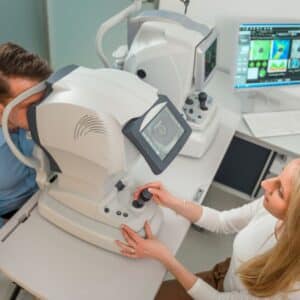Bilateral myopia, a common visual impairment affecting people of all ages, presents unique challenges to clear vision. This comprehensive guide will delve into the intricacies of bilateral myopia, shedding light on its causes, symptoms, diagnosis, and available correction methods. Whether personally impacted by this condition or seeking to understand it better, this article aims to provide a clear and informative overview of bilateral myopia and its implications for visual health
Causes of Bilateral Myopia
Bilateral myopia, characterized by nearsightedness in both eyes, arises from anatomical and genetic factors. This section explores the underlying causes that contribute to this prevalent vision impairment.
- Elongated Eyeballs: One of the primary causes of bilateral myopia is the elongation of the eyeballs. When the eyeball becomes elongated from front to back, it disrupts the normal light-focusing process, leading to blurred vision for distant objects. This elongation typically occurs during periods of rapid growth, such as childhood and adolescence.
- Curvature of Corneas and Lenses: An excessively curved cornea or lens can also result in bilateral myopia. When these structures are overly curved, light entering the eye is focused in front of the retina rather than directly on it. This distortion of light causes distant objects to appear blurry.
- Lens-Cornea Interaction: In some cases, the relative positioning of the lens and cornea can contribute to bilateral myopia. If these structures are positioned too close or far apart, it can affect how light is refracted onto the retina, leading to myopic symptoms.
- Genetic Influence: Genetic predisposition plays a significant role in developing bilateral myopia. Individuals with a family history of myopia are likelier to develop the condition. Certain genes associated with eye growth and development are believed to contribute to myopia development.
Understanding these causes can provide insights into the complex interplay between genetic factors and anatomical changes that result in bilateral myopia. By recognizing these underlying mechanisms, we can better appreciate the reasons behind the prevalence of this condition and explore strategies for managing and correcting it effectively.
Symptoms of Bilateral Myopia
Bilateral myopia, characterized by nearsightedness in both eyes, manifests through various visual and physical symptoms. These symptoms are typically experienced in both eyes simultaneously, causing difficulty focusing on distant objects. Here are the common symptoms associated with bilateral myopia:
- Blurry Vision: Distant objects appear unclear and out of focus. This blurriness can vary in intensity depending on the degree of myopia.
- Squinting: Individuals with bilateral myopia often squint when trying to see objects at a distance. Squinting temporarily changes the shape of the eye’s lens, helping to bring objects into clearer focus.
- Headaches: Straining to see distant objects can lead to eyestrain and tension headaches. The effort to focus on blurry objects can cause discomfort in the forehead and temple area.
- Eye Strain: Reading or working on close-up tasks for prolonged periods can lead to eye strain in individuals with bilateral myopia. This strain is often accompanied by discomfort, itching, or tiredness in the eyes.
- Visual Fatigue: The constant struggle to bring distant objects into focus can result in visual fatigue. This may lead to decreased attention span and reduced productivity, particularly during activities that require clear vision at various distances.
It’s important to note that these symptoms can fluctuate over time. As individuals age or engage in different activities, the severity of symptoms may change. Regular eye check-ups are crucial to monitor the progression of bilateral myopia and ensure that appropriate corrective measures are taken to maintain optimal vision. If you experience any of these symptoms, consulting an eye care professional is advised for accurate diagnosis and effective management.
Diagnosing Bilateral Myopia
Accurate diagnosis of bilateral myopia, a condition characterized by nearsightedness in both eyes, involves a comprehensive eye examination conducted by a qualified eye care professional. This thorough evaluation helps determine the degree of myopia and guides the appropriate course of action. Here’s what you can expect during the diagnostic process:
- Visual Acuity Test: The eye care professional will begin by assessing your visual acuity using an eye chart. This test measures how well you can see objects at various distances.
- Refraction Test: A refraction test is performed to determine the exact degree of myopia. You’ll look through a series of lenses while indicating which ones provide the sharpest vision. This helps determine the correct prescription for corrective lenses.
- Retinal Examination: The doctor uses specialized instruments to examine the retina and optic nerve at the back of the eye. This evaluation checks for any abnormalities or signs of underlying eye conditions.
- Pupil Dilation: In some cases, the eye care professional may dilate your pupils using eye drops. This allows for a more comprehensive view of the retina and aids in detecting any issues that may not be visible otherwise.
- Measurement of Eye Length: To assess any elongation of the eyeball, the doctor may use ultrasound or optical coherence tomography (OCT) to measure the length of the eye.
- Family History Evaluation: Discussing your family history of myopia and other eye conditions helps provide a comprehensive picture of your eye health and potential risk factors.
Properly diagnosing bilateral myopia lays the foundation for effective management and corrective strategies. Regular eye examinations, especially for individuals with a family history of myopia, are essential for monitoring the condition’s progression and ensuring timely intervention to maintain optimal visual health.
Treatment of Bilateral Myopia
Bilateral myopia, characterized by nearsightedness in both eyes, can be effectively managed and corrected through various treatment options. These approaches aim to improve vision and enhance daily life for individuals affected by this condition. Here are the primary treatment methods for bilateral myopia:
- Prescription Eyeglasses: Prescription eyeglasses are a common and straightforward solution for correcting bilateral myopia. Specially designed lenses help bend incoming light rays to focus directly on the retina, providing clear vision for near and distant objects.
- Contact Lenses: Unlike eyeglasses, contact lenses offer an alternative way to correct bilateral myopia. Contacts sit directly on the eye’s surface and provide clear vision without needing frames. They can be preferred for individuals seeking a more natural appearance and enhanced peripheral vision.
- Refractive Surgery: Refractive surgeries such as PRK (Photorefractive Keratectomy) and LASIK (Laser-Assisted In Situ Keratomileusis) are viable options for individuals seeking a more permanent solution. These procedures reshape the cornea, allowing light to focus correctly on the retina. Refractive surgery is typically recommended for adults once their myopia stabilizes.
- Orthokeratology (Ortho-K): Ortho-K involves wearing specially designed contact lenses overnight. These lenses gently reshape the cornea while you sleep, temporarily correcting myopia. The effects last throughout the day, reducing the need for corrective lenses.
- Atropine Eye Drops: In some cases, atropine eye drops may be prescribed to slow down myopia progression, especially in children. These drops dilate the pupil and relax the focusing mechanism, potentially preventing further elongation of the eyeball.
- Regular Eye Exams: Regular eye exams are essential regardless of the chosen treatment. They allow eye care professionals to monitor the progression of myopia, adjust prescriptions, and recommend appropriate interventions based on individual needs.
It’s important to consult with an ophthalmologist to determine the most suitable treatment option for your specific condition. Each individual’s visual needs and preferences vary, and a personalized approach ensures the best possible outcome in managing bilateral myopia and maintaining optimal eye health.
Variations in Myopia
Myopia, commonly known as nearsightedness, exhibits various forms and degrees of severity that impact individuals differently. Understanding these variations is crucial for effectively managing the condition and providing appropriate interventions. Here are the key variations in myopia:
- Unilateral vs. Bilateral Myopia: Myopia can affect one eye (unilateral) or both eyes (bilateral). Bilateral myopia, where both eyes are nearsighted, is the focus of this article.
- Different Degrees in Each Eye: Individuals can have different degrees of myopia in each eye. One eye may be more nearsighted than the other, leading to varying levels of blurred vision.
- Monovision: Monovision is a specialized approach where one eye is intentionally corrected for near vision while the other is corrected for distance vision. This is often used in presbyopic individuals (difficulty focusing on close objects) along with myopia.
- Antimetropia: Antimetropia refers to having one eye nearsighted (myopic) and the other eye farsighted (hyperopic). This unique condition can pose challenges in binocular vision and depth perception.
- Progressive Myopia: Some individuals experience progressive myopia, where nearsightedness worsens gradually over time. This phenomenon can have implications for long-term vision health.
- High Myopia: High myopia, also known as severe myopia, occurs when nearsightedness is -6.00 diopters or more. This condition may increase the risk of certain eye complications, such as retinal detachment and glaucoma.
- Pathological Myopia: Pathological myopia is a severe nearsightedness beyond typical refractive errors. It can lead to structural changes in the eye, affecting the retina and potentially causing vision-threatening complications.
- Secondary Myopia: Myopia can also be secondary to other conditions. For instance, trauma, certain medications, or systemic disorders can induce myopic shifts in vision.
Recognizing these variations in myopia underscores the diverse ways the condition can present. It emphasizes the importance of personalized assessment and tailored treatment plans to address specific needs and challenges. Regular eye examinations, especially for those with high myopia or other risk factors, are vital for monitoring and managing these variations to ensure long-term visual well-being.
Conclusion
Bilateral myopia, characterized by nearsightedness in both eyes, is a common condition with multifaceted implications. We gain insights into managing this visual challenge by understanding its origins, recognizing its symptoms, and exploring effective treatment avenues.
Genetic factors, elongated eyeballs, and corneal irregularities contribute to its development, leading to symptoms like blurry vision, squinting, headaches, and eye strain.
Treatment options, including eyeglasses, contact lenses, and refractive surgeries, offer a range of solutions tailored to individual needs. Moreover, variations within myopia, such as differing degrees between eyes and high myopia, underline individuals’ diverse experiences.
By staying proactive with regular eye exams and personalized care, those with bilateral myopia can effectively manage their vision and enjoy optimal visual health.






